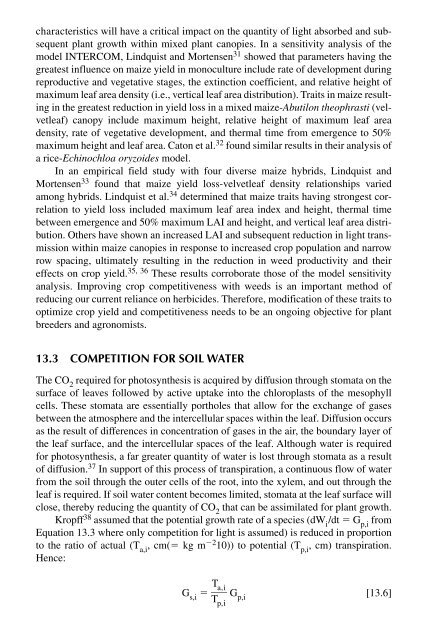Biotic Stress and Yield Loss
Biotic Stress and Yield Loss
Biotic Stress and Yield Loss
- No tags were found...
You also want an ePaper? Increase the reach of your titles
YUMPU automatically turns print PDFs into web optimized ePapers that Google loves.
characteristics will have a critical impact on the quantity of light absorbed <strong>and</strong> subsequentplant growth within mixed plant canopies. In a sensitivity analysis of themodel INTERCOM, Lindquist <strong>and</strong> Mortensen 31 showed that parameters having thegreatest influence on maize yield in monoculture include rate of development duringreproductive <strong>and</strong> vegetative stages, the extinction coefficient, <strong>and</strong> relative height ofmaximum leaf area density (i.e., vertical leaf area distribution). Traits in maize resultingin the greatest reduction in yield loss in a mixed maize-Abutilon theophrasti (velvetleaf)canopy include maximum height, relative height of maximum leaf areadensity, rate of vegetative development, <strong>and</strong> thermal time from emergence to 50%maximum height <strong>and</strong> leaf area. Caton et al. 32 found similar results in their analysis ofa rice-Echinochloa oryzoides model.In an empirical field study with four diverse maize hybrids, Lindquist <strong>and</strong>Mortensen 33 found that maize yield loss-velvetleaf density relationships variedamong hybrids. Lindquist et al. 34 determined that maize traits having strongest correlationto yield loss included maximum leaf area index <strong>and</strong> height, thermal timebetween emergence <strong>and</strong> 50% maximum LAI <strong>and</strong> height, <strong>and</strong> vertical leaf area distribution.Others have shown an increased LAI <strong>and</strong> subsequent reduction in light transmissionwithin maize canopies in response to increased crop population <strong>and</strong> narrowrow spacing, ultimately resulting in the reduction in weed productivity <strong>and</strong> theireffects on crop yield. 35, 36 These results corroborate those of the model sensitivityanalysis. Improving crop competitiveness with weeds is an important method ofreducing our current reliance on herbicides. Therefore, modification of these traits tooptimize crop yield <strong>and</strong> competitiveness needs to be an ongoing objective for plantbreeders <strong>and</strong> agronomists.13.3 COMPETITION FOR SOIL WATERThe CO 2required for photosynthesis is acquired by diffusion through stomata on thesurface of leaves followed by active uptake into the chloroplasts of the mesophyllcells. These stomata are essentially portholes that allow for the exchange of gasesbetween the atmosphere <strong>and</strong> the intercellular spaces within the leaf. Diffusion occursas the result of differences in concentration of gases in the air, the boundary layer ofthe leaf surface, <strong>and</strong> the intercellular spaces of the leaf. Although water is requiredfor photosynthesis, a far greater quantity of water is lost through stomata as a resultof diffusion. 37 In support of this process of transpiration, a continuous flow of waterfrom the soil through the outer cells of the root, into the xylem, <strong>and</strong> out through theleaf is required. If soil water content becomes limited, stomata at the leaf surface willclose, thereby reducing the quantity of CO 2that can be assimilated for plant growth.Kropff 38 assumed that the potential growth rate of a species (dW i/dt G p,ifromEquation 13.3 where only competition for light is assumed) is reduced in proportionto the ratio of actual (T a,i, cm( kg m 2 10)) to potential (T p,i, cm) transpiration.Hence:a,iG s,i T GT p,i[13.6]p,i

















